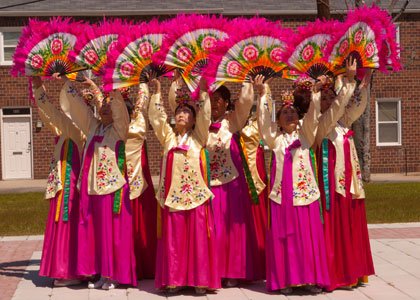Last summer, after riots and unrest gripped Baltimore in the wake of the death of Freddie Gray, much attention was focused on poverty and city communities that regularly find themselves in the throes of violence.
Dr. Jay Perman, president of the University of Maryland, Baltimore, noted that concentrated poverty has held generations of Charm City residents hostage to crumbling neighborhoods, scarce services, poor health, high crime and widespread incarceration. Perman acted.
(Courtesy photo)
Dancers wow the audience with a traditional Korean fan dance. Maryland First Lady Yumi Hogan invited members of the Korean community— including dancers, musicians and food vendors such as Honey Pig— to participate in the spring festival to celebrate the Community Engagement Center’s grand opening
On Saturday, April 16, 2016, the UMB held an official grand opening for a new Community Engagement Center in the Poppleton neighborhood.
“We all use the term anchor institution, and it implies to me and others, that you’re doing something for the community in which you live,” Perman said. “We feel West Baltimore is not just the community that is adjacent, or across the street.”
The center is located on the first floor of a garage that serves the university’s BioPark, a 12-acre development that houses private biotechnology firms, clinical facilities and university research centers. It will eventually comprise a dozen buildings, generating 2,500 jobs and $1.2 billion in capital investment, according to Perman.
The center offers services like resume writing assistance, job search help, legal advice and blood pressure screenings and it’s been described as a virtual one-stop-shop for various services that the campus has offered its neighbors for years, in addition to new services like exercise and wellness classes and workforce training and job fairs.
Perman said the goal is to make it more convenient for residents to take advantage of services at the university, which some may have felt uncomfortable because of the campus location.
Despite any prior misgivings, Perman says some have taken advantage of the school’s free services like dental screenings for children.
Now, having a front door that notes the availability of the engagement center, more residents will likely feel a lot more comfortable coming in for assistance. The services at the center are provided by faculty, staff and students who are in programs including: medicine; nursing; law; pharmacy; social work; and dentistry.
When planning the Community Engagement Center last year, Perman says officials studied various programs to determine whether they merit scaling.
The center also includes a mentoring program that prepares students for high-paying jobs in the health sciences, a program that connects— or reconnects— students’ parents to the job market, and a training program that helps local businesses compete for the millions of dollars UMB spends each year on products and services.
“We’ll engage our neighbors in shared problem-solving, doing the tough research on complicated issues that underpin inequity and helping residents advocate for the policies and programs that will end it for good,” Perman said. “This kind of work is important to helping residents take advantage of economic opportunity, but it cannot, on its own, stimulate the significant economic development that West Baltimore desperately needs.”
In the 1990s, millions of dollars went into a multi-party effort to turn Freddie Gray’s Sandtown-Winchester neighborhood around— to build and renovate houses, establish health care programs and improve local schools. And, while this private-public venture did enjoy some successes, the leaders themselves acknowledge a major failing, specifically that there was no economic driver to keep redevelopment going beyond the initial investment, and services like job skills training did little good given that there were few jobs to get.
“West Baltimore needs smart investment. West Baltimore needs good jobs. And UMB’s BioPark is vital to attracting both,” Perman said. “This is good for everyone, because successful technology parks are home to more than technology companies. They stimulate diverse development to serve the growing population — housing, restaurants, retail, services — and they entice entrepreneurial residents to start businesses that meet new local needs.”

